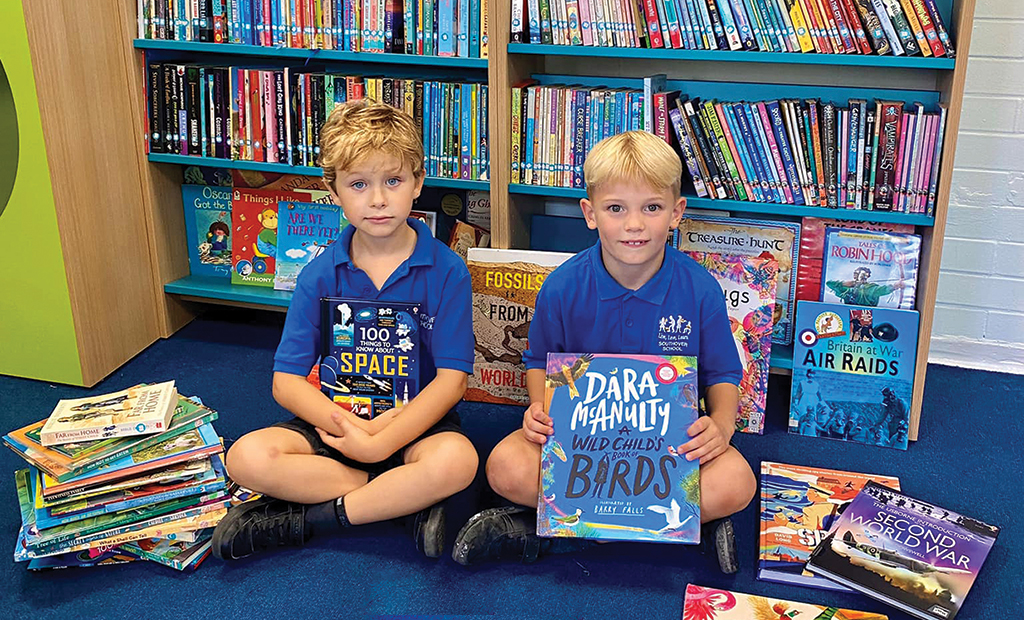Reading for pleasure is declining. A survey by the National Literacy Trust in 2024 found that only one in three children (35%) enjoy reading in their free time. While screens play a role in this trend, a lack of access to high quality reading matter is also a significant factor. Even children with plenty of books at home benefit from exposure to a wide selection of reading options. This variety helps them discover what they like to read and lets them explore different genres and topics on their own.
Yet, in the UK, one in seven primary schools does not have a library, rising to one in four in disadvantaged areas. The Department for Education does not currently collect any data on school libraries and Ofsted does not evaluate or inspect them. Mary-Rose Grieve, co-chair of Great School Libraries, says this lack of information makes it impossible to act on national trends to raise standards in an evidence-based way.
Time spent reading is one of the key indicators of a child’s future outcomes. In addition to developing cognitive skills, such as language, critical thinking and comprehension, reading offers social and emotional benefits. It can help children cope with grief, gain a better understanding of themselves and spark conversations about difficult topics.
Last year, the Chartered Institute of Library and Information Professionals (CILIP), the Association of Senior Children’s and Education Librarians, the School Library Association and the CILIP Schools Library Group (CILIPSLG) sent a joint letter to the new schools minister, Catherine McKinnell MP. In the letter, they urged the government to make school libraries statutory and to provide qualified professionals to staff them. They also called on the Department for Education to start collecting data on school libraries.
Create a vision
If you’re looking to establish a library, there are three main components to consider: the available reading materials, physical space and resources, and the staff who run it. As well as the initial setup costs, each element will require ongoing funding to ensure long-term success. Factor in how you will maintain the area, keep stock levels consistent, fund staff and purchase new resources.
One person’s rigid vision is unlikely to inspire, so make it a team effort. Gather your stakeholders together to define the library’s goals and explore potential sources of funding. Key participants may include the headteacher, English subject lead and school librarian, and representatives from the parent body and pupils. The PTA are likely to be in a strong position to engage the parent and local community, and can also work with pupils to create a sense of unity and collaboration.
To determine the best location for the library, identify what you will need it to accomplish: Will it be large enough to hold your books? Will the school use it for intervention groups, small teaching groups or phonics? Will teachers take a class of 30 children there for story time?
Good habits
The School Library Association guidelines recommend that primary libraries contain ten to 15 books per pupil. It advises 15 books per pupil for secondary libraries, increasing to 20 in sixth form.
Mary-Rose Grieve adds: ‘The minimum number of books a primary school library should contain, regardless of pupil numbers, is 2,600. If a library has fewer books, it may struggle to meet the interests and abilities of all the pupils.’
Not all children read the same way. As well as providing books that cater to different ages and reading abilities, Louis Coiffait-Gunn, CEO of CILIP, recommends ‘including reading materials that appeal to different kinds of readers and encourage a lifelong love of reading. This includes non-fiction, picture books, graphic novels, comics and magazines. Look for engaging fiction by diverse authors with different perspectives. Provide books that support escapism, mental health and wellbeing.’
Louis advises stocking books that promote media and information literacy, helping pupils think critically and recognise misinformation. Other options include audiobooks and e-books, along with the necessary listening devices, and resource boxes designed for different areas of the curriculum. ‘Jigsaws, card games, board games, colouring and book-making stations can all encourage creativity and collaboration while enhancing literacy skills,’ he adds.
While space in school buildings is often tight, Christopher White, managing director of library design company BookSpace, suggests schools resist the temptation to make the library too multifunctional. ‘When it tries to serve too many purposes, a library can lose the positive reading experience, turning into a non-space or even a dumping ground,’ he says.
Carry out online research to get a feel for how you want the library to look. Primary schools often theme their libraries. Christopher notes: ‘A custom design, such as a treehouse in the centre of the room with archways leading to different zones, will be much more expensive than a classic library setup with standard book displays, tables, chairs and comfortable seating.’ Alongside furniture and shelving, consider what other kind of work might be needed: Do you need to change the flooring? Does the room need decorating? Will you install new lighting?
‘When we go into schools, there’s often a board displaying pupils’ ideas. Some schools establish a focus group, where one child from each class can share feedback, others opt for a questionnaire. One placed a stack of Post-it notes outside the lunch hall so pupils could write down their suggestions and stick them to the wall.’
Expert guidance
In many primary schools, the job of running a library frequently falls to a busy teacher or group of parent volunteers, often on top of existing responsibilities and with little training. However, a trained librarian can have a huge impact on pupil outcomes. Caroline Roche, chair of CILIPSLG, says a dedicated librarian is a ‘worthwhile investment in literacy for the whole school. They will help raise literacy levels by working with teaching colleagues, parents and pupils. They will know which books to select and can match them to the child.’
‘If there is a Schools Library Service in your area, you can buy into their expertise,’ she continues. ‘Through this service, your school may be able to hire a librarian for one day a week. CILIPSLG can also recommend a school library specialist who can assist you in setting up your school library and provide occasional ongoing support.’
Mary-Rose describes how a school librarian is not only a keeper of books: ‘They are teachers, curriculum planners, administrators, counsellors, accountants, designers and trainers; they are disruptors, agents for change, non-conformists, collaborators, and strategists.’
Libraries for life
As you work through the project, start looking for ways to keep your library at the heart of the school, perhaps by organising an annual fundraising book fair, regular readathon or library maintenance day. Your school librarian can play a vital role in finding additional sources of funding, arranging author visits and facilitating storytelling workshops.
Investing in a library enriches education and helps pupils become lifelong learners, equipping them with essential skills for a changing world. It also encourages a fun activity that opens minds, promotes compassion and relieves the pressure of busy lives.
Next steps:
- Find book ideas and reviews at bestbooksforschools.com and booksforkeeps.co.uk. Specialist suppliers such as Peters, Browns and Norfolk Children’s Book Centre can provide curated collections of books
- Read positive stories highlighting the impact of libraries across the UK at CILIP’s Libraries Change Lives campaign
- Take a free course developed by CILIPSLG through the Open University
- Read the Great School Libraries framework document, designed to help school leaders understand how they can find and fund a school librarian
- Read Creating a School Library with Impact (Facet Publishing, 2022), an invaluable guide for school librarians
- Find further training at cilip.org.uk/page/TrainingandCPD
Sharing information about the library helped us reach our fundraising target
We used to have a pop-up library, but it had been moved around a lot and was eventually packed away. In 2021, the school approached us about setting up a permanent library in a dedicated, accessible space.
We’ve got a good, active group of parents who raise funds continually, and we work well and closely with the school. But we knew that a library requires more than a few bake sales and non-uniform days and we’d need to raise a large amount of money.
The headteacher came to us with a ready-made design for a library area from a company called BookSpace, and a quote for the cost that included shelves, stools, toadstools and a rug. It came to just under £13,500. On top of that there would be extras, including all the new books and stickers to catalogue them, as well as painting, decorating and electrical work.
Our town places great value on its independent shops and the school was keen to buy books from a local firm. Children’s bookshop Bags of Books put together a wish list for us, with a good mix of titles from poetry to black history, making sure to cover a wide range of themes. We still use them now – the Friends have pledged to continue adding to the stock every year. Teachers recently fed back that graphic novels are particularly popular, so we’ve just ordered some in.
As soon as we knew how much we needed to raise, we started posting on our social media channels and sending newsletters to the parent community. We’ve noticed that we hit our fundraising targets when we are very specific about what we’re fundraising for and how the children will benefit. So we posted pictures of the library design to allow people to see what we were hoping to get. One Facebook post resulted in a very generous donation from someone who wanted to remain anonymous, which was incredible. The headteacher also successfully applied to a local trust for £5,000 and the PTA had to agree to match that amount, which we knew we’d be able to do.
During that time, all our fundraising activities, such as discos and family fun nights, were specifically held with the aim of raising money for the library.
Once we hit our target, I applied to Tesco to be one of the blue token beneficiaries and my bid was successful. Again, we spread the word on social media, and we spent that money on more books.
The children love their library. My family has a lot of books at home, but my son still enjoys going to the school library and choosing books for himself.
The teachers make such great use of the space – they take the pre-schoolers for a library session before they even start at the school. It’s been such a positive experience for everyone involved.
Carolyn Sparks, chair, Friends of Southover Primary School, Lewes (310 pupils)
Fundraising for a library
Although the school may provide some funding for the library, it is unlikely to be able to cover the entire project. Kevin Parker, chief financial officer at the Little Way Catholic Educational Trust, highlights several ways schools can put their capital funding towards a library project: ‘As part of a building improvement and maintenance programme, schools can use capital funding to invest in seating, furniture and shelving systems to maximise the available space. They can direct funds towards upgrading technology, for example by setting up digital workstations equipped with computers or tablets, as well as using it to implement security and inventory systems.’
The school and PTA can work together to identify grant funding opportunities. Ask if anyone on the PTA committee or in the parent community is interested in learning about how to apply for grants. Some schools set up a separate grants working group for precisely this purpose. The PTA can also assist with reaching out to alumni and asking for donations from the local community. They can contact the local or parish council, approach local charities, such as the Rotary Club, and apply for supermarket token schemes.
A library project provides an ideal opportunity to launch larger fundraisers and community events, such as fun runs, garden parties and festivals. Top up your fundraising by holding literacy-based fundraisers. Many PTAs find that working together on a major project strengthens their relationship with the school.
- Find ideas for literacy fundraisers
- Ten tips for your dream school library
While library projects usually attract a lot of support and positive feelings, securing all the necessary funds can take several years, so it’s important to involve the whole community from the start. Keeping everyone updated with regular information helps maintain enthusiasm and support. Once your team has a clear idea of what it hopes to achieve, create a timeline that outlines the steps needed to complete the library, start gathering estimates and evaluating potential funding options, and set a deadline.







